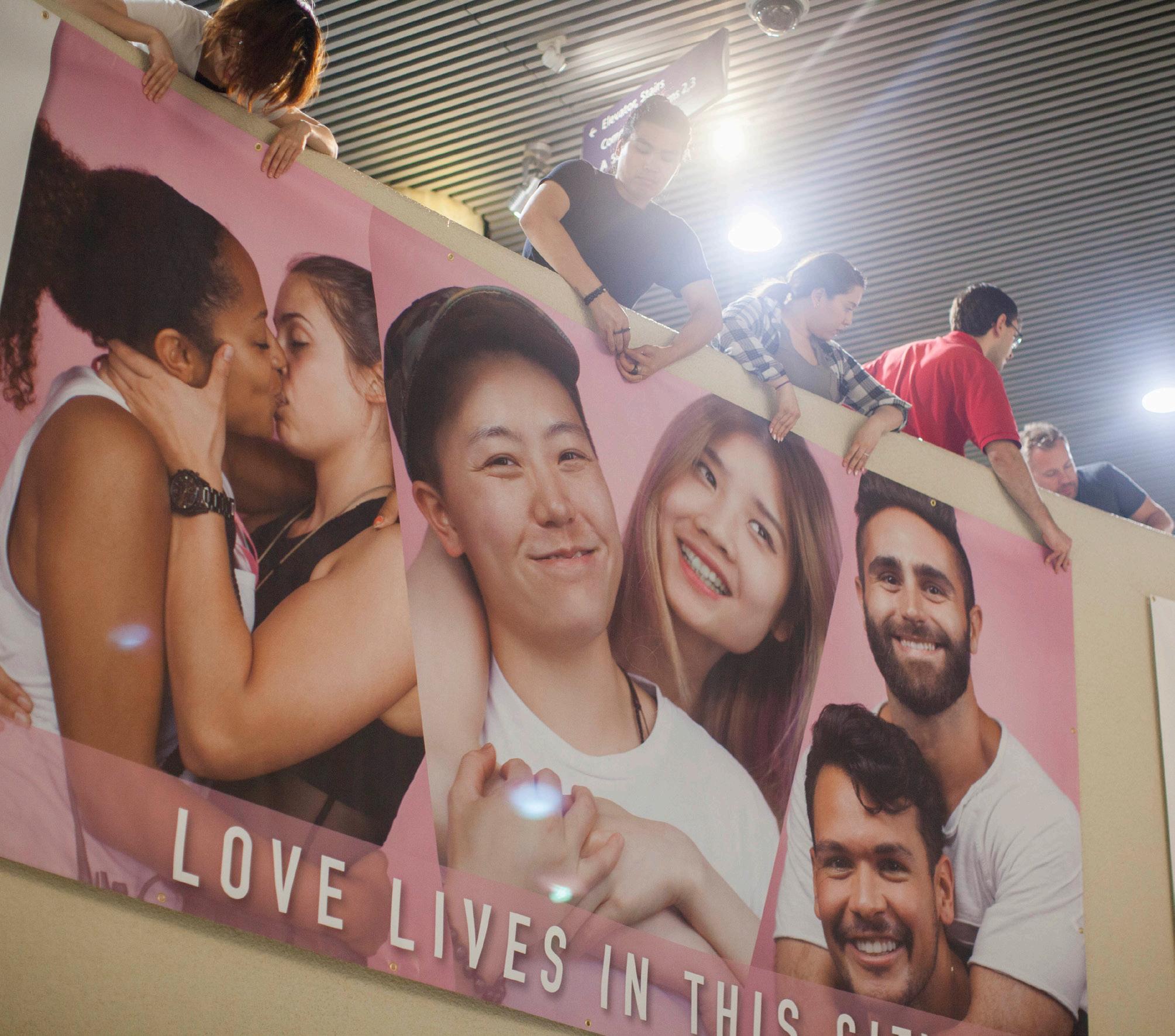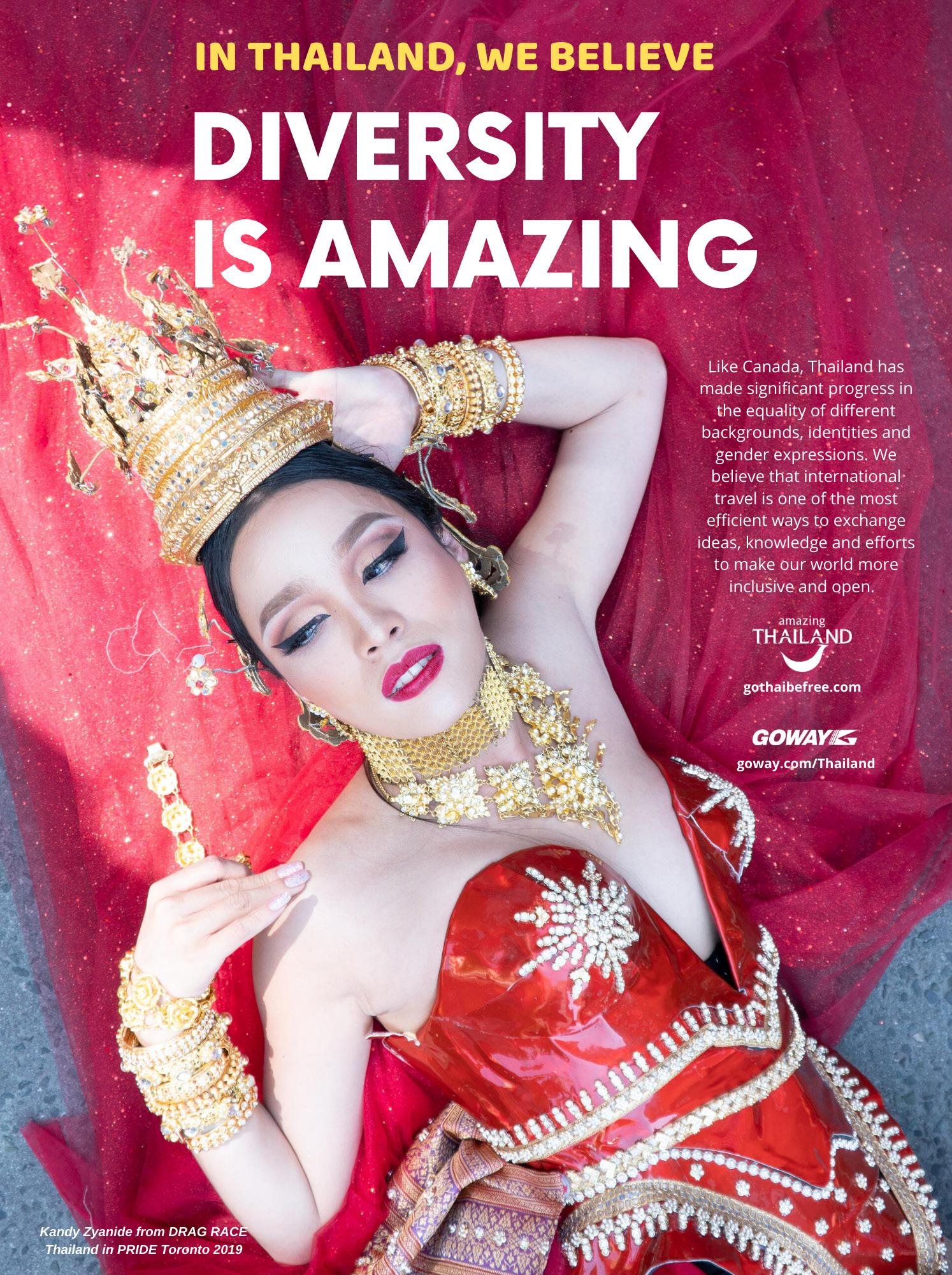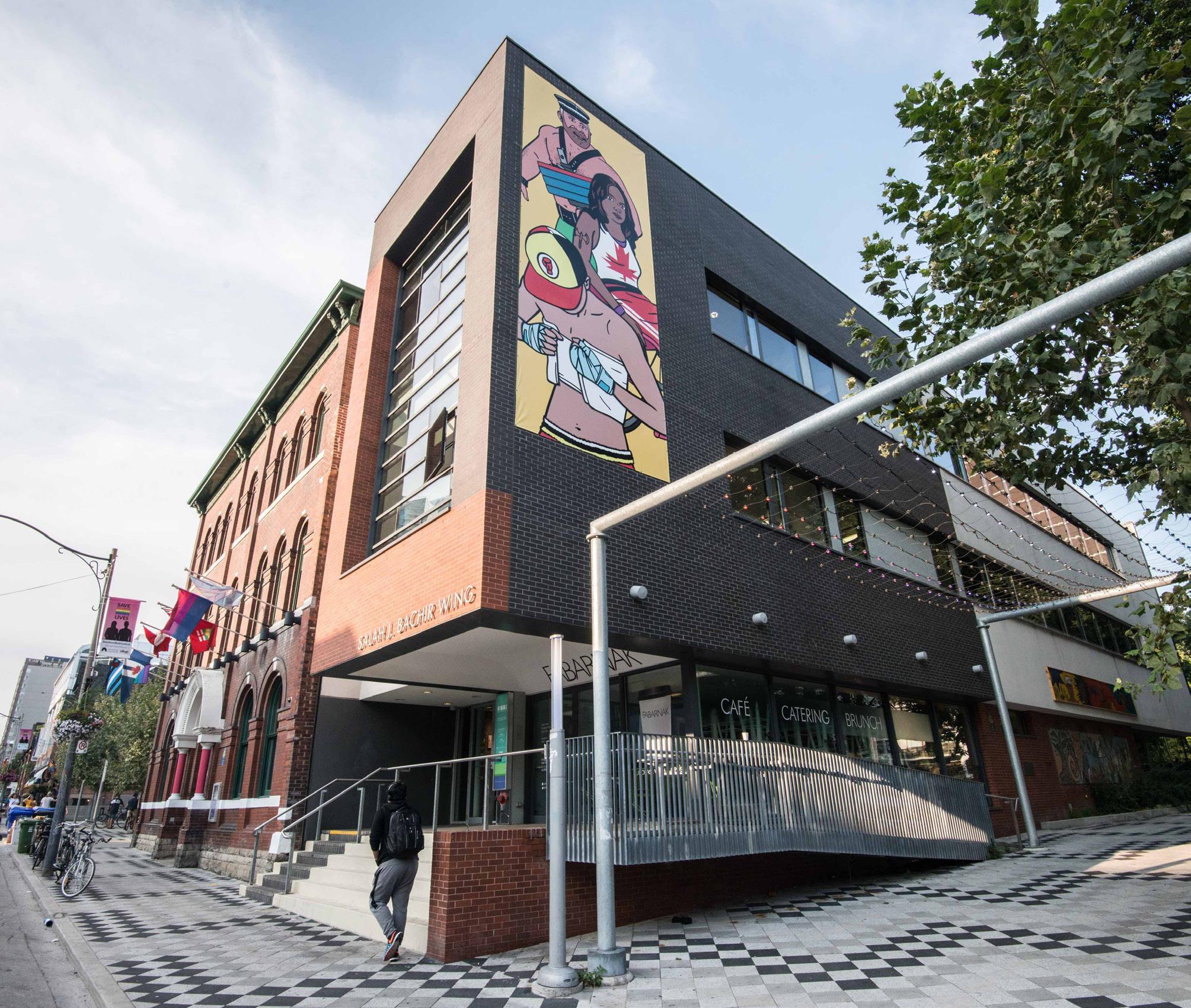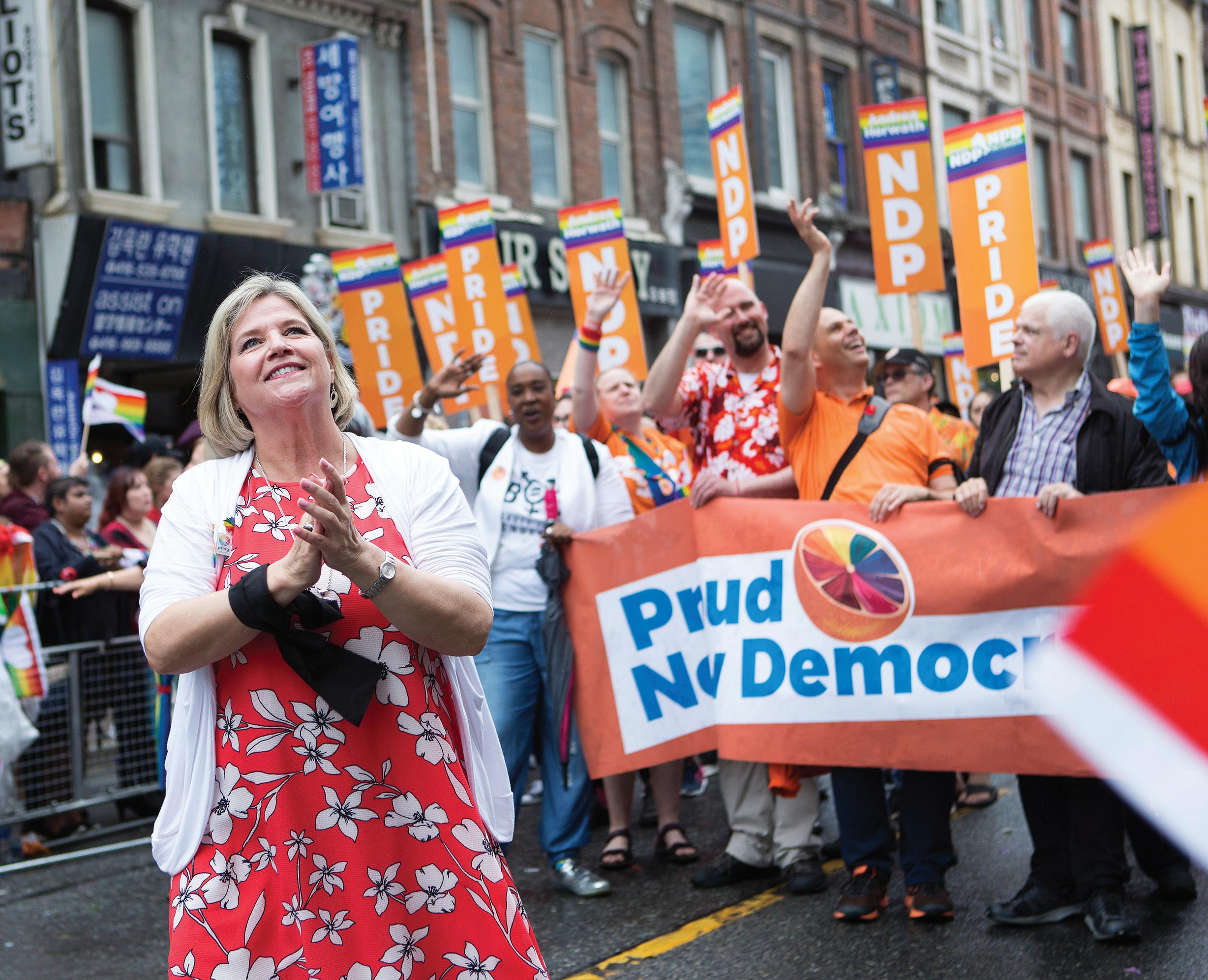
12 minute read
CORPORATIONS BELONG IN PRIDE
Clearing up some misconceptions about the role of corporations in Pride
By Adam Zivo
There’s no shortage of controversy about the role of corporations in Pride parades. Many believe that corporate involvement is necessarily exploitative; that it signifies nothing more than clever marketing, an attempt to dupe a community into buying products without offering real support for their rights. Associated with that belief is the idea that corporate involvement ultimately dilutes Pride’s politics and, in this way, turns Pride away from its political origins. There’s some legitimacy to these views, but on the whole, critics of corporate involvement in Pride tend to have serious misconceptions about how the entire process works and, above that, take a narrow view of how LGBTQ+ advocacy operates.
It’s something I’ve observed in my experiences as an LGBTQ+ activist. I founded an LGBTQ+ advocacy campaign, LoveisLoveisLove, which I’ve managed for a few years now. This campaign has produced several major installations focusing on broadening the base of support for LGBTQ+ rights through art and education, and I’m proud of what we’ve accomplished. It all cost money, though, and so I familiarized myself with the back-end of rainbow capitalism. My views on rainbow capitalism are rooted in those experiences. The points I bring up here aren’t completely exhaustive of all of the ethical and political issues entangled in the corporatization of Pride, because that kind of essay could go on for a very long time. However, I hope there’s enough here for people to reconsider popular narratives and catch onto some of the nuances those narratives miss.
The reality of corporate involvement
A misconception about corporate involvement in Pride is that it’s an invasion of outsiders into the LGBTQ+ community. In reality, rainbow capitalism is not spearheaded by boardrooms of old, straight executives conspiring together to exploit the gay dollar. For the most part, Pride initiatives are spearheaded by LGBTQ+ employees, who leverage their deep connections with the community to attempt, as best they can, to create programming that’s relevant to it. If, for whatever reason, LGBTQ+ employees are not able to provide leadership, then companies usually ask trusted LGBTQ+ community members to vet the company’s ideas. As a result, corporate Pride programming is, more often than not, created by community members for community members.
In practice, the question of profits and pink dollars rarely comes up. When it does, it’s as a secondary concern, taking a back seat to a genuine enthusiasm for positive engagement with LGBTQ+ communities.
It’s no accident that the heavy involvement of LGBTQ+ employees is often missed. It’s purposefully invisible. You can broadly divide Pride programming into two categories. First, you have internal programming, which is meant for the company’s employees and is designed to foster a more inclusive work culture. You also have external programming, which is meant for the general public. While internal programming can focus on a company’s LGBTQ+ employees, external programming almost always prioritizes abstract ideas, like diversity and inclusion. That’s because these abstract ideas are most relevant to the broadest cross-section of society.
Suppose your public-facing programming focuses on your company’s employees. While that’s nice, it also might not really resonate with people who don’t work for your company. It also runs the risk of making your Pride engagement seem preoccupied with patting yourself on the back for your inclusivity, rather than supporting the community as a whole. Focusing on abstract ideas is an easy way to remove those risks and send out a message that that is relatable to most people.
A side effect of this approach is that, in committing to messages that are universal and accessible, community engagement professionals inadvertently hide the personal stories and grassroots interactions that happen on the back-end. The public sees rainbow flags and feel-good slogans, but they don’t see the LGBTQ+ employees working behind the scenes to make that happen, earnestly working to maximize the impact of community engagement budgets. Everything that gives this process its soulfulness is kept behind a curtain. What’s left can feel cold and impersonal. Programming seems to come out of nowhere, and in the absence of information, people tend to assume the worst, believing that the underlying motive behind corporate programming is predatory.
Regardless of the presence of LGBTQ+ folks in the program development process, there are still critics who are firmly convinced that corporations get involved in Pride parades in bad faith. For those critics, it’s often important to find some kind of hypocrisy within a corporation’s past and present behaviour. For example, in 2017, at the Capital Pride in Washington, DC, activists protested against the inclusion of Wells Fargo as a sponsor, since the company also financially supported the Dakota Access Pipelines.
There are a few problems with this approach, which stems from a fundamental misunderstanding of how corporations operate. For the most part, people underestimate how complex and decentralized corporations are. Corporations aren’t people. They’re sprawling ecosystems of teams and hierarchies. While these disparate pieces roughly work towards the same end, they’re still fragmented and don’t, by default, communicate closely with one another – and this fragmentation gets worse the larger a corporation is. When a corporation seems to act inconsistently, that’s more a reflection of decentralization, with different teams pursuing different goals, rather than wilful hypocrisy or bad faith behaviour.
Using Wells Fargo as an example, the team in charge of Canadian community engagement is going to have very little to do with the team responsible for American pipeline investments. To strictly hold one team morally responsible for the actions of another team, just because they operate under the same corporate umbrella, isn’t reasonable or productive.
It’s an idea people seem to recognize when we talk about government sponsorship. It seems widely understood, for example, that part of the Government of Ontario might fund Pride Toronto while another part pursues policy or funding choices that are implicitly homophobic. Where are the spicy opinion articles about how LGBTQ+ organizations should refuse provincial funding so long as the Ford administration holds power? Or, to use another comparison: how many people would argue that Trump’s bigoted policies oblige LGBTQ+ organizations to refuse funding from the US federal government? No one argues that.
Governments are relatively open and transparent, and citizens interact with government agencies enough to appreciate that they don’t coordinate well. That leaves us with an appreciation for public sector fragmentation, and how the different parts of a government might have competing priorities. Corporate organizations aren’t really that different, though by their very nature they’re much more private about this. Concerns about corporate hypocrisy deflate a lot when that’s kept in mind.
Money needs to come from somewhere
If it’s true that corporations, at least when engaging with Pride, aren’t as predatory and hypocritical as some believe, is that really enough to justify taking corporate dollars? No. Intentions matter, but they aren’t everything. What also matters is the end effect of corporate involvement. You can have the best intentions and still do harm, after all. So what’s the end effect of corporate dollars? Autonomy and equity. Funding needs to come from somewhere, and corporate sponsorship is the best option of what’s available.
Speaking broadly, funds can come from four different sources: the private sector, the public sector, individual donors and festival attendees. If you refuse corporate donations, you hollow out private sector support, since all that remains in that category is small businesses, which don’t have the resources to fund Pride festivals at the levels we’re accustomed to. In lieu of that, you can look at the other categories, but they each bring their own set of problems.
Individual donors are a minor source of funding. Pride Toronto is a great case study for this, so let’s look at their finances. In 2019, Pride Toronto’s revenues were $6.4 million, of which only $100,000, or 1.5 per cent, came from individual donations. In contrast, corporate sponsorships brought in $3.7 million. To expect individual donors to make a dent in the funding gaps that would be left by a corporate exodus is, to put it frankly, delusional.
What about collecting funds from festival attendees? Pride Toronto already does that somewhat through beverage sales, which bring in around $200,000. But as with individual donations, that’s just a drop in the bucket relative to Pride Toronto’s financial needs. You could, if you wanted, try charging an admission fee to attend events at Pride, but that would invite a hot mess of logistical and ethical issues. On the logistics side, building out that infrastructure means taking on new burdens – the extra volunteers and financial costs to enforce a fee structure; the impact fee collection would have on government funding support; reductions in attendance; and so on.
More important than the logistical questions are the ethical ones. User fees would create a two-tiered Pride where economically disadvantaged community members are implicitly excluded or
discouraged from participating. Yet these community members are the ones who would benefit most from Pride. Pride’s mandate is to provide LGBTQ+ folks with both a social space and a platform for political advocacy. Community members with means can always use their wealth to access for-profit LGBTQ+ social spaces, or press their political priorities through other channels (money is power, after all). For the most marginalized LGBTQ+ members, alternative options for advocacy and community building are scarcer. A Pride that is substantially funded by attendee fees would be a Pride that, rather than uplifting the most vulnerable, would annually remind them of their second-class status. From an equity lens, that’s indefensible.
Government funding has its caveats
What about relying primarily on government funding? That’s already a substantial revenue stream. Pride Toronto, acting as a case study again, receives a substantial amount of funding from the different tiers of government. For technical reasons, the exact figures are hard to come by, but the City of Toronto invested $260,000 in Toronto Pride in 2016, the Government of Ontario put in $250,000 in 2019, and the Government of Canada invested $400,000 in 2009. Taken together, these numbers fall far short of what corporate sponsors bring in, but at the very least, it’s plausible to imagine a corporate-free Pride that operates on beefed-up government support. Inviting as that seems, though, that’s not the kind of Pride we should strive to achieve.
In general, the more diverse your sources of funding are, the more autonomy you have. When you have a diversified pool of funders, if one funder becomes problematic, you can replace them. Even major sponsors can be substituted, and though that process might be fiscally painful, it’s at least possible. The corporate sector offers that diversity, because there’s an abundance of businesses out there that could be approached for sponsorship, making each business fairly interchangeable. The public sector is different. While there’s a web of players that LGBTQ+ organizations can approach for funding, since large government grants are given to non-profits to redistribute as smaller grants, ultimately funding comes from three entities: the municipal, provincial and federal governments. In such a small field, each is influential.
This is a problem because, if a government acts unreasonably and holds funding hostage, there’s no alternative government to go to. It’s true that playing the different levels of government against each other can offer LGBTQ+ organizations some freedom to manoeuvre. Using a non-LGBTQ+ comparison, in 2017 the federal Liberals beefed up funding for affordable housing, focusing on sending funds directly to municipalities, which helped offset cuts by the Ford government. However, if there were ever a time in the future when the political winds turn against the LGBTQ+ community, with hostility extending across multiple levels of government, then relying too heavily on public purse strings would amplify our vulnerability.
Consider that, when the Harper government cut $400,000 in funding from Pride Toronto in 2010, and when Toronto city council threatened to cut its funding in 2017, these were not existential threats to Pride precisely because Pride had so much revenue from corporate sponsors. A historically marginalized community can resist hostile governments if it has independent funding, but is less able to resist if its support systems go broke when they are needed most. When looking at things from this lens, the reliance on corporate sponsorships is about utilizing the power of Big Business to provide some insurance against political whims. This tension is already

playing out in Trump’s America, where Big Business regularly attempts to counteract the damage inflicted by a homophobic political climate. It’s also seen outside LGBTQ+ politics. A poignant example would be the response to Alabama’s near-total ban on abortion in 2019. Corporate America vocally opposed the bill. It applied pressure to state lawmakers by insinuating that the ban would lead to decreased investment in the state, creating an economic penalty for regressive policy. Whether Big Business can provide an effective counter to homophobic politicians is up for debate, but at the very least, it’s better than being totally out in the cold.
In Canada, our political climate in Canada is fairly accepting of the LGBTQ+ community. To talk about pitting business against government, and treating corporate support as a kind of insurance, may seem far-fetched or remote, but it’s important not to be myopic about politics.
Americans in 2015 did not predict Trump’s circus of hate. Similarly, LGBTQ+ Canadians should be cognizant of how fickle politics can be, and take a farsighted view on how cultivating different kinds of allies ultimately creates more security.
How to improve corporate engagement
If corporate dollars are important and seemingly necessary, what can we do to make corporate engagement better? It’s simple: we need to guide corporate sponsors towards providing more meaningful engagement with the LGBTQ+ community. Businesses are risk-averse, which is why they typically take the safest path on LGBTQ+ engagement: wantonly slathering rainbows on things. As they become more experienced with engagement, their strategies tend to evolve. TD Bank is an example of this. Being the first major bank to support Canadian Pride festivals, they spent years peddling branded Speedos and muscly go-go boys. Realizing that this wasn’t substantive, they recently shifted their strategy to one that finances and celebrates grassroots community initiatives.
As of now, so many companies are still fresh to vocally supporting the LGBTQ+ community, and are stuck in the rainbows-on-everything phase. Rather than criticizing them for this, let’s instead nudge them towards improvement, towards going beyond just rainbows and finding other ways to support LGBTQ+ communities. It will take time, and they’ll make mistakes along the way, but that’s fine. It’s part of a larger process of cultivating a type of ally.










